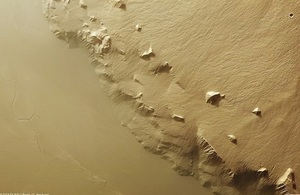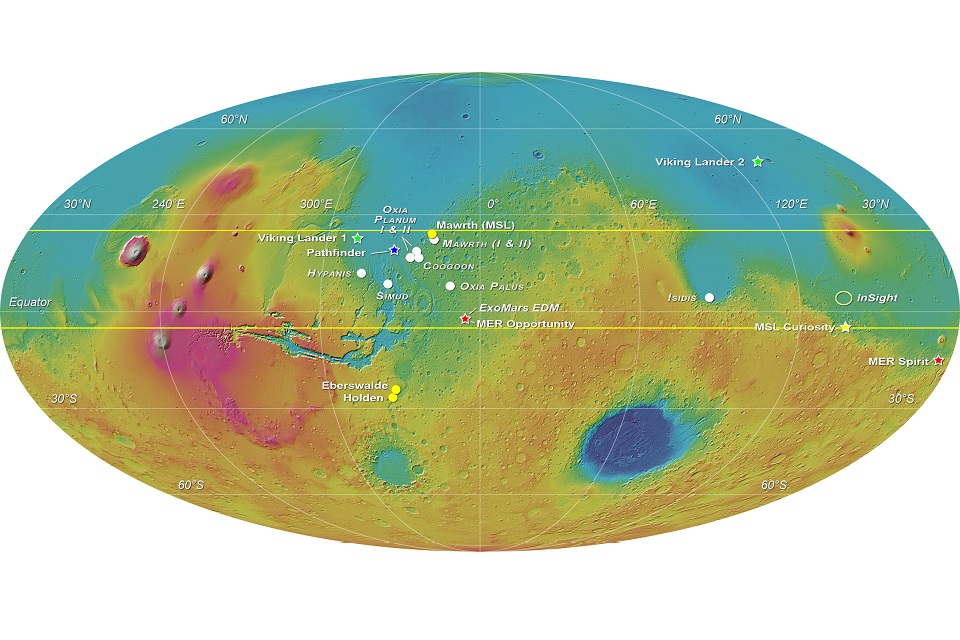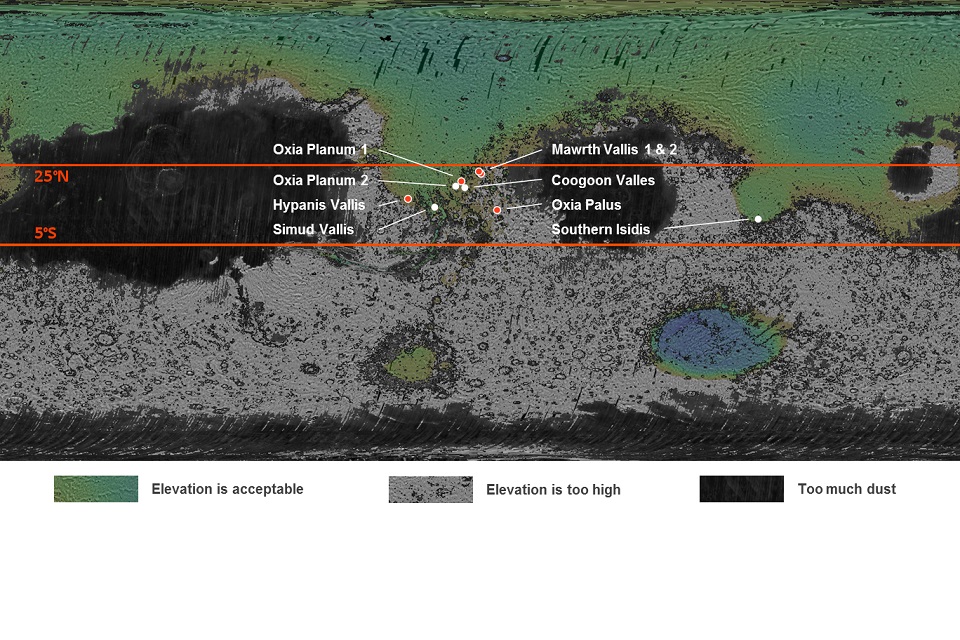Scientists favour four ExoMars landing sites
A shortlist of suitable landing locations for Europe's first Mars rover has been drawn up.

Olympus Mons SE flank. Credit: ESA/DLR/FU Berlin (G. Neukum)
Some 60 scientists and engineers came together last month (26–28 March) for the first ExoMars 2018 Landing Site Selection Workshop, held at ESA’s European Space Astronomy Centre near Madrid. Their task was to begin the process of drawing up a shortlist of the most suitable landing locations for Europe’s first Mars rover.

MOLA elevation map of Mars with the eight landing sites proposed for the ExoMars 2018 mission. Credit: ESA-Roscosmos/LSSWG/E. Hauber
ExoMars, a joint endeavour between ESA and Russia’s Roscosmos space agency, comprises two missions for launch to Mars: the Trace Gas Orbiter and an entry, descent and landing demonstrator module, Schiaparelli, to be launched in 2016; and the ExoMars Rover and Surface Platform scheduled for launch in May 2018, with touchdown on Mars expected in January 2019. The UK arm of Airbus Defence and Space is building the rover for the second phase of the mission and there is considerable UK involvement from a number of academic institutions with the on-board instruments.
The key driver behind the choice of landing site for the 2018 mission is the rover’s search for evidence of Martian life, past or present.
A call for landing site proposals was issued last year by ESA and the Space Research Institute of the Russian Academy of Sciences, IKI (on behalf of Roscosmos). Eight proposals that were judged to be most appropriate to the mission’s requirements were discussed during the recent workshop, and an initial shortlist of four favoured locations was drawn up at the end of the meeting.
Scientific criteria
Present day Mars is a hostile place for living organisms - a frigid desert bathed in high doses of ultraviolet and ionising radiation. However, there is a possibility that primitive life may have gained a foothold when the climate was warmer and wetter, between 3.5 and 4 billion years ago.
Clearly, the ExoMars landing site should be an area of ancient rocks where liquid water was once abundant, preferably in a region that shows signs of sustained or frequently recurring aqueous activity, such as river channels and lakes.
On Earth, biosignatures can be found in fine-grained sedimentary rocks deposited by slow-moving water, for example, in alluvial plains or river deltas. Some of these rocks, such as clays, are very good at capturing and retaining organic compounds. Clay minerals are also evidence of sustained weathering by ground water of low acidity.
On the other hand, large doses of ionising radiation sterilise the surface and penetrate the Martian subsurface, contributing to the destruction of possible biosignatures. In order to find ancient biomarkers in a good state of preservation, the deposits containing them must have been buried for most of the planet’s history and thus protected, until recently, from radiation damage.
One further complication is the covering of fine dust which blankets much of Mars. The ExoMars rover will search for molecular biosignatures by drilling into the subsurface, collecting samples and then analysing them in its onboard chemical laboratory. The vehicle can drill to a maximum depth of 2 m, so the dust cover at each site should ideally be very thin or non-existent.
Time is of the essence if the maximum scientific return from ExoMars is to be achieved. The rover can cover a limited driving range in the course of its 7 month nominal surface exploration mission. The spacecraft’s ballistic entry into the atmosphere is a rather imprecise procedure which means that it could land anywhere within a 104 km x 19 km ellipse. In order to ensure that the rover spends as much time as possible conducting scientific research, a landing ellipse should contain a scattering of suitable sites to ensure that at least some of them are accessible to the rover.
In addition to these scientific requirements, the use of parachutes to slow the spacecraft’s descent restricts the landing sites that can be chosen. In particular, candidate sites must all lie at least 2 kilometres beneath the mean planetary reference level – the Martian equivalent of sea level. This is to ensure that the spacecraft can fly through a sufficiently long atmospheric trajectory for its parachute system to operate properly.
Other important engineering constraints include surface gradients, which if too steep could fool the descent module’s radar, the size and distribution of rocks that may topple or damage the lander, and wind speed.

The four sites favoured by scientists at the first Landing Site Selection Workshop. Credit: ESA-Roscosmos/LSSWG/D. Loizeau
The candidate sites
The workshop attendees favoured 4 candidate sites – all of which are located relatively near the equator - that were considered to be the most likely to achieve the mission’s objectives. They are: Mawrth Vallis (for which 2, very similar, proposals were received), Oxia Planum, Hypanis Vallis and Oxia Palus.
The area around Mawrth Vallis and nearby Oxia Planum contains one of the largest exposures of ancient, clay-rich rocks on the planet. Both regions contain rock types that may have been favourable for complex organic chemistry, and layered rocks that may preserve evidence of past life. Also, some of these deposits seem to have been exhumed within the last few hundred million years, thus reducing their exposure to radiation.
The other 2 sites represent former fluvial environments. Hypanis Vallis is characterised by fine-grained sedimentary rocks associated with an ancient delta located at the end of a major valley network. Oxia Palus is a region of sedimentary rocks that was buried by impact ejecta and other deposits and has only been exhumed relatively recently.
Over the next few months, members of the ExoMars Landing Site Selection Working Group (LSSWG) will seek to improve their understanding of the scientific and engineering implications associated with each of these 4 locations, while also devoting some attention to the 3 remaining sites - Coogoon Valles, Simud Vallis and Southern Isidis.
The LSSWG will then recommend a final shortlist of up to 4 candidate sites in June 2014, prior to a more detailed analysis. The aim is to complete the certification of at least 1 landing site for the ExoMars rover by the second half of 2016. The final decision on the landing site will be taken sometime in 2017.